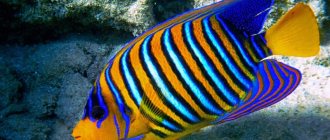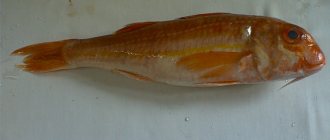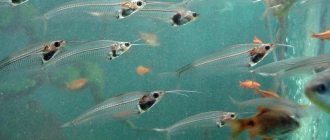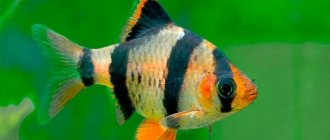- Blob fish
Our Earth is 70% water and most of these vast water (including underwater) expanses remain poorly explored. Therefore, it is not at all surprising that the most amazing and strange representatives of the animal world live in the depths of the sea. Today in our article we will talk about the most incredible deep-sea fish of the Mariana Trench and other ocean depths. Many of these fish were discovered to the human eye relatively recently, and many of them amaze us people with their incredible and even fantastic appearance, structural features, habits and way of life.
Mandarin duck / Synchiropus splendidus
The small and colorful inhabitant of the oceans got its name due to its resemblance to the bright clothes of the Chinese mandarin.
The colorfully patterned fish lives close to coral reefs, preferring sheltered, calm lagoons and coastal reefs.
Because of their beauty, tangerines are also popular as aquarium fish, but keeping them in aquariums is quite difficult, since it is difficult for them to choose food. The mandarin duck is rightfully one of the most beautiful inhabitants of the seas and oceans. In addition, it is included in our rating of the most beautiful animals on the planet.
2
Deep sea fish video
And in addition to our article, we invite you to watch an interesting video about 10 incredible creatures of the Mariana Trench.
Author: Pavel Chaika, editor-in-chief of Poznavaika magazine
When writing the article, I tried to make it as interesting, useful and high-quality as possible. I would be grateful for any feedback and constructive criticism in the form of comments on the article. You can also write your wish/question/suggestion to my email [email protected] or Facebook, with respect, the author.
Author page
Lionfish / Pterois radiata
A beautiful fish from the scorpionfish family can pose a threat to humans. And the inhabitant of the deep sea received this name because of its fins, which, when developing, resemble the mane of a lion.
The lion fish hunts, driving small fish into recesses or among reefs, and swallows them with great speed. Injections from sharp fins, which contain toxic poison, are dangerous to human life and health.
By the way, on most-beauty.ru you can also learn about the most poisonous fish on our planet.
3
Predators of the sea
Among ocean fish, sharks are far from the only predators. There are many other aggressive representatives.
Moray eel likes to hide. To do this, she uses caves, coral reefs and thickets of vegetation. The body is quite elongated; with a length of three meters, its thickness is only 30 centimeters. It has a strong jaw, which it actively uses when hunting. Easily camouflaged and attacks from ambush, holds prey tightly with its mouth, uses its tail to hold or tear the victim. With poor eyesight, he has an excellent sense of smell.
One of the dangerous sea predators is the moray eel, which tears its prey with its long tail.
Barracudas are somewhat similar to giant three-meter pikes. They are dangerous to human health and can bite off limbs and cause other injuries. They attack suddenly and indiscriminately, including eating poisonous food. Because of this, their meat is toxic and is not used in gastronomy.
The swordfish is larger in size than many sharks - three meters long and almost half a ton of mass. The most dangerous part of the body is the long bone growth on the upper jaw.
Because of its resemblance to a sword, the fish got its name. Thanks to the four-ton impact force, the swordtail is capable of breaking through an oak board half a meter thick. The predator has no scales.
The danger of this fish is the growth on the upper jaw that resembles a sword.
The European fishing rod is also called the devil. This is due to its extremely unattractive appearance. Its wide mouth is shaped like a crescent moon, its lower jaw is extended, and its eyes are located close to the middle of its head. On the long fin above the upper jaw, bacteria actively multiply and attract fish. If the bait does not work, the anglerfish can rise up and swallow whole a bird that has landed on the surface of the water.
Tuna is a predator that prefers to gather in schools. Its four-meter body can weigh half a ton, but the fish can swim at a speed of 90 kilometers per hour. Tuna is actively used in gastronomy; the French even call it sea veal.
Pelamida also has a silver color, but is much smaller in size. It is no longer than 85 centimeters and weighs no more than 7 kilograms. There are faint stripes on the back that have a blue tint. The fish gather in schools and hunt for sardines and anchovies.
Imperial angel. Pomacanthus imperator
The coral dweller not only has a romantic name, it is also one of the most beautiful fish of the ocean depths.
The purple body of the angel is decorated with bright yellow stripes with an orange tint. The emerald head of the imperial angel has a characteristic, amazingly beautiful mask around the eyes.
Interestingly, the fish changes its color throughout its life. The young are black with white and blue stripes.
4
Psychedelic frogfish (English: Psychedelic Frogfish, Latin: Histiophryne psychedelica).
Opened in 2009. A very unusual fish - the tail fin is curved to the side, the pectoral fins are modified and look like the paws of land animals. The head is large, the widely spaced eyes are directed forward, like in vertebrates, due to which the fish has a peculiar “facial expression”. The color of the fish is yellow or reddish with sinuous white-blue stripes diverging in different directions from the blue eyes. Unlike other fish that swim, this species moves as if jumping, pushing off the bottom with its pectoral fins and pushing water out of the gill slits, creating jet thrust. The tail of the fish is curved to the side and cannot directly direct the movement of the body, so it oscillates from side to side. The fish can also crawl along the bottom using its pectoral fins, moving them like legs. (David Hall/EOL Rapid Response Team)
Triggerfish Picasso / Rhinecanthus aculeatus
The triggerfish has an unusual, even strange coloring. The belly is almost white, but the back is greenish-olive in color. A black stripe with a bluish border runs through the eyes, as if separating the head from the body.
The inhabitant of the Indian-Pacific region is quite aggressive, but wastes its aggression mainly on its relatives. This unusual fish loves to swim in warm, shallow waters, among reefs and rock crevices.
5
Fish of the Red Sea. Kingdom of diversity
Over millions of years of existence, the ancient sea is filled with underwater inhabitants in huge quantities. One and a half thousand fish have been studied and described by humans, but this is less than half of the inhabitants of the mysterious body of water.
Not a single river flows into the warm sea. This factor contributes to the preservation of clean water and the development of a special living world. The fish of the Red Sea are unique. Many species are not found in other bodies of water.
Parrot fish. Scaridae
Photo by: Rickard Zerpe
It received such an unusual name not because of its bright color, but because of its mouth, similar to a bird’s beak. With the help of the powerful front part of its head, it crushes small mollusks and crustaceans.
All representatives of this species have an unusual and bright color. But while sleeping in sea waters, they form an unusual cocoon of mucus, which protects the fish from natural enemies.
Giant amoebas
American oceanographers 6 years ago discovered living creatures at a record depth of 10 km. – gigantic
amoebas. True, they no longer belong to fish, so among fish the primacy is still occupied by bassogigas, but these giant amoebas are the absolute record holders among living creatures living at the greatest depth - the bottom of the Mariana Trench, the deepest known on Earth. These amoebas were discovered using a special deep-sea camera, and research into their life continues to this day.
Clownfish / Amphiprion
The warm and vibrant waters of the Red Sea in the Indian and Pacific oceans are home to the amazing clown fish. It got its name due to its unusually bright color and active behavior.
There are 28 species of clown fish in the ocean depths. Interestingly, all young individuals are males, and then during their lives they all change sex to female. And the stimulus for such a change is the death of the female.
This beautiful fish gained worldwide fame after the release of the cartoon Finding Nemo.
7
Edible
The modern development of culinary arts, chemistry and other sciences is such that the presence of waterfowl poisons in the body does not make them inedible. Almost all of the underwater breeds listed above can be eaten, each of them has fans in different countries.
But the cooking methods are quite complex, require the skill of the cook and are associated with a certain risk to the life of both the one who cooks and the one who eats.
To be able to cook fugu you actually need to get a diploma. It’s easier with perch fish – just learn how to carefully remove the spines and fins. Katrans, eels, stingrays, and dragons are also eaten.
The opposite is also progressing. Due to deteriorating ecology and pollution of sea waters, fish (from large to small), which have been destined for centuries, are becoming increasingly dangerous, especially for children. Harmful metals, the first of which is mercury, most strongly affect the following fish with the following names:
- bluefin tuna;
- sharks;
- sea bass (especially the wild species from Chile);
- tile;
- Atlantic bighead;
- mackerel;
- swordfish;
- Atlantic cod;
- butterfish - escolar;
- red snapper;
- Mahi-mahi.
This sad list is updated every year. Therefore, when purchasing sea fish in a store or at the market, you need to carefully study information about the areas where it is caught and stored, as well as the environmental situation in the sectors of the ocean where it is found. For this purpose, special applications are being developed for gadgets, where you need to upload photos of labels to obtain information. Pacific fish require special attention after high-profile chemical scandals.
Fire Centropyge / Centropyge loricula
One of the brightest and most colorful fish lives among the coral reefs of the Pacific Ocean. Fiery beauties can also be found off the coast of the Hawaiian Islands.
The small fish grows to only 7–10 centimeters in length. The body of the fish is fiery red in color with small vertical black stripes on the sides. It is from the unusual color that the fish received such a sonorous name.
8
Smallmouth macropinna (English, Latin: Macropinna microstoma) is the winner for quirkiness.
Opened in 1939. It lives at very great depths, so it has been poorly studied. In particular, the principle of fish vision was not entirely clear. It was believed that she must experience very great difficulties due to the fact that she can only see up. Only in 2009 was the structure of the eye of this fish fully studied. Apparently, when trying to study it earlier, the fish simply could not tolerate the change in pressure. The most notable feature of this species is the transparent, dome-shaped shell that covers the top and sides of its head, and the large, usually upward-pointing, cylindrical eyes that lie underneath this shell. A dense and elastic covering shell is attached to the scales of the back at the back, and on the sides to the wide and transparent periocular bones, which provide protection for the organs of vision. This covering structure is usually lost (or at least very badly damaged) when fish are brought to the surface in trawls and nets, so its existence was not known until recently. Under the covering shell there is a chamber filled with a transparent liquid, in which, in fact, the eyes of the fish are located; The eyes of living fish are bright green and separated by a thin bony septum, which, extending backwards, expands to accommodate the brain. In front of each eye, but behind the mouth, is a large rounded pouch that contains an olfactory receptor rosette. That is, what at first glance appears to be eyes in photographs of live fish is actually an olfactory organ. The green color is caused by the presence of a specific yellow pigment in them. It is believed that this pigment provides special filtering of light coming from above and reduces its brightness, allowing the fish to discern the bioluminescence of potential prey. (Monterey Bay Aquarium Research Institute)
Source
Blue surgeon. Paracanthurus hepatus
The fish with such an unusual name became the prototype of the main character of the Disney cartoon. Lives in tropical waters from the coast of Africa to Japan.
The body of the animal is ovoid in shape with flattened sides, colored blue with dark stripes. But the caudal fin stands out sharply in yellow.
9
Herring fish - names, photos
Marine fish of this species are distinguished by the fact that they do not have a single scale on their heads . They have very small teeth and no or very short lateral line. The most important commercial species of herring are:
- European sprat;
- European sardine;
- Pacific herring;
- Atlantic herring;
- Atlantic menhaden.
Sea herring meat has a large amount of protein, polyunsaturated fats, and vitamin A.
Seal harness. Pterapogon kauderni
Photo credit: / CC BY-SA
The homeland of this unusual fish is the Indonesian island of Bangai. Lives mainly in large groups of up to 500 individuals.
It stands out among other exotic species for its large caudal and dorsal fins, which have black stripes. Convex eyes on a relatively small body indicate that the fish are very active in the dark.
10
Blobfish (Latin: Psychrolutes marcidus).
Opened in 1926. Often mistaken for a joke. In fact, this is a completely real species of deep-sea bottom-dwelling marine fish of the psycholute family, which on the surface takes on a “jelly” appearance with a “sad expression.” It has been poorly studied, but this is enough to recognize it as one of the most bizarre. The photo shows a copy from the Australian Museum. (Kerryn Parkinson/Australian Museum)
Discus. Symphysodon
From the waters of the Amazon River basin, the beautiful fish spread throughout the world and became popular in aquarium fish farming. The design has nine vertical stripes on the body, which is round and flattened on the sides.
Prefers small rivers and calm ponds, avoiding large currents. Discus fish feed mainly on insect larvae and freshwater shrimp.
Terrible sea predators sharks
The most ancient representatives of these individuals existed for about 420 million years .
Currently there are more than 450 species. The smallest shark measures 17 cm. The whale shark is the largest fish, the length of which can reach twenty meters. Sharks are mainly predatory fish, however, some of them feed on small fish, squid and plankton. These include largemouth, basking and whale sharks.
Despite the fact that according to some reports, mercury accumulates in shark meat, it is still used as food by some cultures. Shark fins are used by the peoples of Asia to prepare delicious soups. And its liver contains vitamins B and A , and is used to make various medicines.
Moorish idol. Zanclus cornutus
The second name of this fish, “Horned Zankle,” comes from the Greek word for “sloping.” The inhabitant of temperate and tropical waters has a large, beautiful fin.
The alternating black, white and yellow stripes along the body make the Moorish idol unusually beautiful. It can live at depths of up to 180 meters, choosing mainly areas with a hard seabed.
13
Whale shark - a giant fish in the ocean
The largest of all existing shark species and the largest fish of all living in the oceans. The maximum length of the fish reaches 12.65 meters, there are specimens up to 18 and 20 m in size, weight can vary from 10 to 22 tons. The shark's mouth is very large and reaches a width of 1.5 meters. There are about 300-350 small teeth inside it. Outwardly, this species is not similar to other representatives of sharks.
It is one of the rarest species, the number of which has always been small; over the past 10 years it has been constantly declining. Fishermen from southern Asia especially exterminated the shark; in these places, whale shark meat was eaten. Today it is prohibited to hunt it, but the number of individuals is increasing at a very slow pace. The reason for this is poachers and slow natural growth. To this day, the way of life of fish, its characteristics in behavior and reproduction itself are poorly studied. She is known to be slow and apathetic. It often lives in the very surface layers of water and can descend to a depth of 700 meters. Sharks swim with wave-like movements made by the back of the body, using 2/3 of the entire body. They swim very slowly, about 5 km/hour. They are active around the clock and sleep for short periods, regardless of the time of day.
It is difficult to confuse these large ocean fish with the other largest inhabitants of this species. The body of a whale shark is powerful, strong and thick. The head is small in size, flattened, mainly towards the end of the snout. The wide gill slits are long, the shark has 5 of them in total. The fish can open its mouth very wide; it is located at the end of the snout. A fully open shark's mouth looks like a wide, large oval. The eyes are set deep, they are located very close to the snout, almost at the ends of the mouth, and are small in size. The skin on the back is dark gray-brown, on the belly it is gray-white. In the back area there are patterns of spots and stripes of light color, which together create an original pattern that does not change throughout life, like human fingerprints. At the end of the article there is a video about this largest fish in the ocean.
The whale shark lives throughout the world's oceans and loves warm waters. They can often be found in small groups, rarely alone. If there is an abundance of food somewhere, they arrive there in large clusters of up to hundreds.
Surprisingly, the whale shark only reaches sexual maturity at the age of 35-50 years, which is an exceptionally long time. They live for 70 years or more, cases up to 100 are known. Males predominate over females, sometimes the latter make up only 17% of the total number in the herd. Little is known about the reproduction of the whale shark, although scientists have been observing it for more than 100 years. What is known is that this giant is ovoviviparous, the development of embryos occurs in capsule eggs, and they hatch in the womb. Newborn sharks are very small, about half a meter.
Whale sharks are capable of making very long migrations for plankton. Most often you can find sharks off the Seychelles, near Taiwan, where they live all year round. The most significant number of whale sharks is concentrated in Southeast and East Africa. According to some estimates, about 19% of the entire world population lives in the Mozambican coastal area.
The whale shark's diet mainly consists of plankton; this is their favorite food. Food is filtered from the water using a filtering apparatus, which consists of gill arches connected by 20 cartilaginous plates. Externally, such a device looks like a grate that holds everything you need for food. First of all, the diet consists of:
- plankton
- shrimp
- krill
- fish
- jellyfish
- tuna
When the feeding process is underway, the fish moves slowly, moving approximately 1 meter per second. Often it stops altogether, swaying up and down, only moving its head to the sides with its mouth wide open. At the same time, the shark’s body is held almost vertically, closer to the surface of the water. During feeding, she makes from 7 to 20 swallowing movements per minute, while the jaw moves simultaneously with the gill slits. If a whale shark overeats, its belly protrudes greatly.
Butterfly fish. Pantodon buchholzi
Butterfly fish or mothfish or pantodon live in fresh water bodies of the African continent, but also in the depths of the sea right up to the shores of Southern Japan and Hawaii.
Stripes run through the entire body of this linear fish, and the color is densely saturated with yellow, black and white shades. But the fins are coffee pink with a purple tint.
Butterfly fish usually stay near the surface of the water, hunting for small insects. Can jump out of the water while hunting or escaping from predators.
14
Variety of sharks
Sharks are the most colorful inhabitants of the depths of the seas and oceans. They are occasionally found in large lakes and rivers. There are more than 500 varieties in total. They differ from each other not only in appearance and shape, but also in their lifestyle.
The largest order of carchariformes includes eight families:
- gray;
- mustachioed canines;
- false martens;
- hammerheads;
- big-eyed;
- striped cats;
- felines;
- mustelids.
The largest order of sharks is the carchariformes; almost any shark that comes to mind will be from this order
. They usually live in coastal marine regions of temperate and tropical latitudes. Their common features:
- five gill slits;
- anal fin;
- two dorsal fins.
- nictitating membrane in the eyes.
The tiger shark was so named because of the transverse stripes on the sides of its body. This is one of the most common varieties. Individuals grow up to six meters in length and reach one and a half tons of mass. Indiscriminate in food. Eats crustaceans, turtles, does not disdain sharks of other species, loves to eat marine mammals, birds, sea snakes and fish. Sometimes accidentally swallows objects unsuitable for food. Poses a threat to humans.
It is obvious why the tiger shark got its name; it is unpretentious in food and poses a real threat to humans.
The name of the lemon shark comes from the yellowish tint of its skin. The length of individuals reaches a size of three and a half meters and a weight of 200 kilograms. They are active at night, live in shallow bays and reefs, and can settle in medium-sized ones. Young sharks gather in schools and swim along coastlines overgrown with mangroves. They usually hunt birds, fish and shellfish. Cases of attacks are recorded extremely rarely, but this species is still potentially dangerous to humans.
The blunt-nosed shark was so named because of its short and massive blunt snout. It is considered one of the most dangerous and poses a real threat to human life. The shark lives in fresh water bodies and behaves extremely aggressively, often attacking livestock and domestic animals that enter the river. At the same time, their physical parameters are quite impressive - half a ton of weight with a length of four meters.
The blunt-nosed shark or bull shark also poses a danger to humans
The diet includes sea turtles, fish, smaller sharks, mammals, echinoderms and crustaceans. They hunt by hiding in muddy water, which perfectly camouflages the predator without giving away its approach. The predator attacks many people who do not expect danger.
The lateral fins of the long-finned shark visually resemble airplane wings. The longest known length of an individual is four meters. Weight reaches 200 kilograms. They feed on mollusks and bony fish, but due to hunger they can change their eating habits. Not safe for humans.
The blue shark is very elongated and slender, the pectoral fins stand out for their length. The top of the body is blue, on the sides it smoothly turns into blue, and the belly is contrastingly white. With a length of four meters, the predator weighs relatively much - 400 kilograms. Prefers to hunt crustaceans, fish, octopuses and squids, and does not neglect the corpses of mammals. Not safe for humans.
https://youtube.com/watch?v=RJU6HaPGgKU
The body of the silky shark is relatively soft due to small teeth on the skin. The sides are bronze-gray, in places cast with metal, the belly is light. With a length of three to four meters, it weighs approximately 350 kilograms. This species is distinguished by its particularly acute hearing, which they use for hunting. The majority of the diet consists of fish. Sometimes sharks gather together and herd victims into a large school, and then attack. There have been no recorded cases of attacks on people.
The reef shark is also called the whitetip shark. This is due to the tips of its fins - they are colored white.
Lives in places where there are a lot of corals. Well adapted to reef terrain, it can navigate and hunt well in it. Able to extract potential food from narrow spaces. Has a fairly strong jaw to break coral.
It goes hunting at night, usually catching lobsters, octopuses, crabs and reef fish. With a two-meter length, it weighs quite little - only 30 kilograms. Individuals are aggressive towards humans only in case of self-defense. If you do not provoke a reef shark, it will not attack people.
The reef shark can be distinguished by its small size and colored fin tips
The catshark has an interesting spotted coloration. It also gets its name because of its excellent eyesight, nocturnal habits, and ability to curl up into a ball. The shark's body is small, does not grow longer than a meter, and weighs no more than two kilograms. Individuals catch gastropods, mollusks, crustaceans and echinoderms. Not dangerous to humans.
The mustel shark was also named due to its resemblance to a mammal. It is similar to a marten in coloring, as well as a small flexible body. This predator is very agile and lively, and shows gluttony. Sizes vary greatly from 30 to 220 centimeters, large individuals weigh 30 kilograms. It usually hunts fish, less often mollusks and crustaceans. Almost not dangerous to humans.
The hammerhead shark is well known for its unusual head shape. During the daytime, individuals often gather in large flocks, the numerical size of which can reach a thousand. The longest recorded length is 6 meters. Weight does not exceed 600 kilograms. Typically feeds on stingrays, fish and shellfish. During the hunt, it shows aggression and is therefore dangerous to humans.
The hammerhead shark is dangerous to humans only when hunting for the usual food of stingrays and smaller fish species
The origin of the name soup shark is directly related to gastronomy. The large fins of the predator are considered a delicacy and are used to prepare exotic soup. It grows up to two meters in length, but weighs only 50 kilograms. It eats squid, crustaceans, mollusks and fish. Due to its relatively small size, it is not very dangerous to humans.
There are other large orders of sharks:
- Lamniformes;
- Wobbegong-shaped;
- Katraniformes;
- Polybranchiformes;
- Squatinaceae;
- Heterodonates;
- Sawtooth.
There are several other classes of large sharks, including wobbegongs
Flag perch. Pseudanthias squamipinnis
The habitat of the colored flag perch is the tropical reefs of the Pacific and Indian oceans. Nature generously endowed this amazing fish with colors.
In reference books you can also find the name “Scaltefin”. It is very difficult to keep in aquariums, since in its natural environment it feeds on live food. Like many coral inhabitants, the fish changes sex.
15
Scat Motoro Leopoldi
This freshwater resident, which has a contrasting velvety black coloration with white spots, is popular among collectors due to its spectacular appearance and unpretentiousness. By the way, fish is also considered one of the most expensive - its cost sometimes exceeds two thousand euros. When handling this stingray, care should be taken, since if a fish is pricked by a fish's spine, a long-healing painful wound will form on a person's skin.
The fish looks especially impressive in aquariums that imitate the seabed, and the volume of the container should allow it to swim freely. Motoro Leopoldi gets along well with fish living in the upper layers, but can be aggressive towards individuals of the opposite sex.











